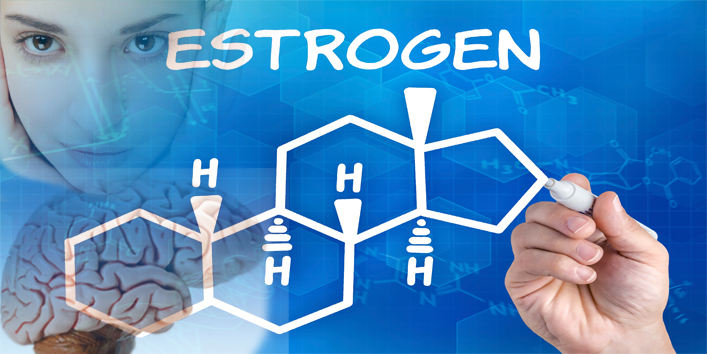Every one of us come across the term estrogen in our lives irrespective of our association to the medical sciences. Estrogen is the hormone, famous for its connection to females. But the fact is that it is also secreted by men. Hormones are referred as the chemical messengers, released into the blood by the human body, which carry the messages from one cell to another and regulate all the functions of the body.
 Image Source:https://wegoforgood.files.wordpress.com
Image Source:https://wegoforgood.files.wordpress.com
Let us begin our journey to understand the different roles of estrogen:
Reproductive roles
Estrogen refers to the group of hormones that regulate the growth and development of female sexual characteristics and reproduction. This family of estrogen has estrone, estradiol and estriol. It is secreted from the ovaries, adrenal glands and fat tissues. The production of different forms of estrogen is stage specific in women. Estradiol and estrone are produced during premenopausal stage from the ovaries while placenta produces estriol during pregnancy.

The secretion of estrogen and progesterone in the women of reproductive age is stimulated by the luteinizing hormone, a hormone secreted by the pituitary gland. Estrogen plays the role in the first part of the menstrual cycle. It stimulates the release of the new egg from the follicles and further thicken the uterus lining. Its secretion is maximum during the ovulation phase while it goes on decreasing gradually from ovulation to menstruation. Estrogen works in collaboration with progesterone, if the fertilization occurs, to prevent further ovulation.
Non-reproductive roles
Bones: Estrogen plays a role in the formation of bones in combination with vitamin D, calcium and other hormones. Up till the age of 30-35 years, the pace of bone formation is higher than the rate of bone resorption. After this bracket age, the rate of bone resorption increases as the estrogen level decreases.
 Image Source:https://www.google.co.in/
Image Source:https://www.google.co.in/
Skin: Estrogen improves the collagen content of the aging skin. It increases the mucopolysaccharides and hyaluronic acid in the skin, which in turn maintains the moisture content of the skin. It benefits the wrinkles due to its action on fibers and collagen. Its role in cutaneous healing has also been established. This hormone also exerts its effect on elastin. The decrease in estrogen in the postmenopausal period produces profound effects on the skin. So, many women undergo for hormonal replacement therapy. But the role of estrogen in HRT still requires more clinical evidences.
 Image Source:https://www.google.co.in/
Image Source:https://www.google.co.in/
Urogenital: The decrease in estrogen diminishes the vaginal lubrication and makes the vaginal walls thinner leading to the painful sex. Diminishing levels of estrogen cause the thinning of urethral walls (tubes that transport the urine to the outside of the body). In certain cases it increases the risk of getting urinary tract infection as evidenced by epidemiological studies. Clinicians prescribe vaginal estrogen therapy for such conditions.
 Image Source:http://images.slideplayer.com/
Image Source:http://images.slideplayer.com/
Lipid metabolism: Estrogen as estradiol plays a vital role in regulating the lipid metabolism in both the adipocytes and in hepatocytes. It is transferred to cells or it may also be produced here from androgens. Estrogen regulates the MRNA synthesis of the proteins that are involved in lipid metabolism.
 Image Source:http://image.slidesharecdn.com/
Image Source:http://image.slidesharecdn.com/
Muscle strength: It has been evidenced that estrogen thwart off the weakness of skeletal muscles. Rather than working on muscle size, estrogen improves the muscle quality by working on the muscle fibers which are responsible for force generation. Hormone therapy for muscle weakness when supplemented with resistance exercise produces better results for women in postmenopausal stage.
 Image Source:http://www.fitnessjunglemag.com/
Image Source:http://www.fitnessjunglemag.com/
Brain: Burgeoning evidences document the role of extraglanduar estrogen (the estrogen produced from the sites other than gonads) in learning, mood regulation and memory. It exerts effect on several neurotransmitters. Estrogen affects the learning strategy rather than rate of learning. Ample evidences state that estrogen improve the learning and decreases the depression. It increases the strength of memory. It serves as neuroprotective to the aging women against neurodegenerative diseases.
 Image Source:https://www.google.co.in/
Image Source:https://www.google.co.in/
Cardiovascular system: The risk of heart diseases is less in premenopausal women as compared to postmenopausal women. This is due to estrogen, which stimulate the secretion of nitric oxide, a vasodilator (dilate the blood vessels).
 Image source:http://images.slideplayer.com/
Image source:http://images.slideplayer.com/
Breast cancer: The prevalence of breast cancer is 100 times more in women as compared to men. Estrogen is the major contributor to breast cancer. Estrogen binds to the estrogen receptors in the cancerous cells and leads to their proliferation. The absence of estrogen starves the cancer cells and they will not grow.



